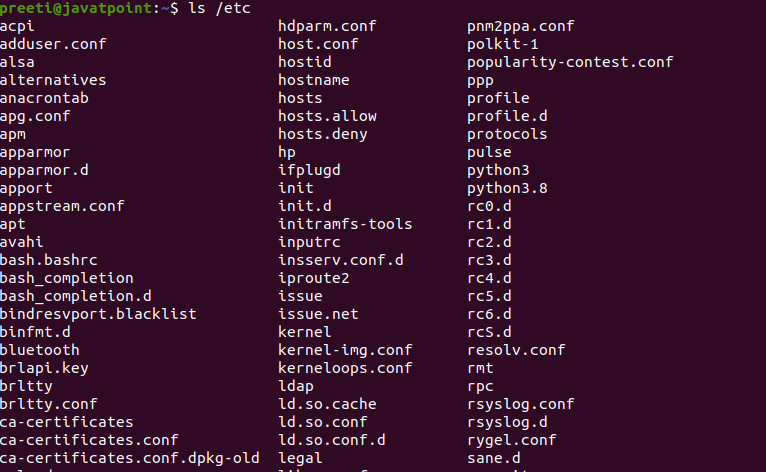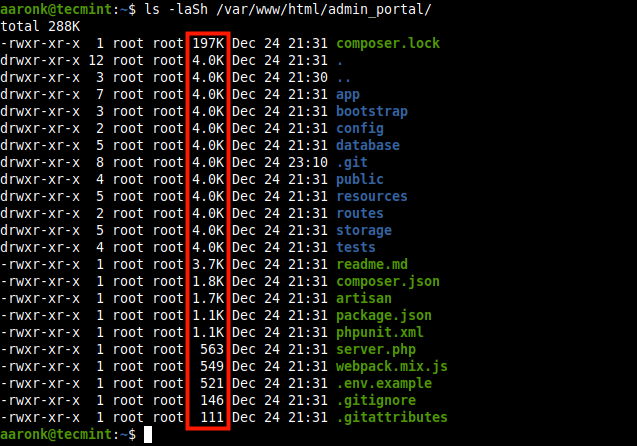

Type the ls -d */ command to list only directories: List files with subdirectories Type the ls ~ command to list the contents in the users's home directory: List only directories for contents two levels above: List files in the user's home directory (/home/user) command to list the contents of the parent directory one level above. Type the ls / command to list the contents of the root directory: List files in the parent directory Type the ls command to list the contents of another directory: List files in the root directory Type the ls command to list the contents of the current working directory: List files in another directory In other words, flags change how the ls command works: ls PS: The word contents used in throughout the article refers to the files and directories being listed, not the actual contents of the files/directories ? List files in the current working directory The ls command also accepts some flags (also known as options) which are additional information that changes how files or directories are listed in your terminal.
#List directory contents that start with in linux how to#
Launch your terminal and type ls to see this in action: How to list Files in a Directory with Options Just like you navigate in your File explorer or Finder with a GUI, the ls command allows you to list all files or directories in the current directory by default, and further interact with them via the command line.

The ls command is used to list files or directories in Linux and other Unix-based operating systems. Basic knowledge of navigating around the CLI.Have one of the Linux distros installed.In this article, we'll go in depth on the ls command and some of the most important flags you'll need day-to-day. The ls command is one of the many Linux commands that allow a user to list files or directories from the CLI. The Linux shell is a REPL ( Read, Evaluate, Print, Loop) environment where users can enter a command and the shell runs it and returns a result. One amazing feature of the Linux operating system is the Command Line Interface (CLI) which allows users to interact with their computer from a shell. It's open source, and is used all over the world across many industries. Linux is one of the most popular Unix based operating systems. Many of these operating systems failed, while others succeeded. Prevent group members and all others to read or modify the file secret.Since the creation of Unix in the 1970s, a lot of operating systems have used it as their foundation.Non-specified permissions are not affected.

To do this, you specify the list of users ( u for the owner, g for the group, o for other users, a for all), followed by a + to add permissions or - to remove permissions, which is then followed by a list of permissions to modify ( r for read, w for write, x for execute). The simple way to use it is to specify which permissions you wish to add or remove to which type of user. The chmod command allows you to change file permissions. So if your home directory has drwx- permissions and contains a subdirectory with drwxr-xr-x permissions, other users cannot read the contents of this subdirectory because they do not have access (by the executable bit) to its parent directory.Īfter listing the permissions, ls -la command gives a number, followed by the file owner's name, the file group's name, its size, last modification date, and name. Important note: to be able to read or write in a directory, you need to have execute permissions ( x) set in all parent directories, all the way up to the filesystem's root ( /). drwx-wx-wx: a directory that everybody can enter and modify but where only the owner can list its contents.drwx-x-x: a directory that can only be listed or modified by its owner, but all others can still pass it on their way to a deeper subdirectory.-rw-: a file that can only be read and changed by its owner.-rw-rw-: a file that can be read and changed by its owner and by its group.-rw-r-r-: a world-readable file that can only be changed by its owner.-rwxr-xr-x: a world-readable and world-executable file that can only be changed by its owner.drwxr-xr-x: a directory that can be listed by everybody, but only the owner can add or remove files.drwxrwxrwx: a world-readable and world-writable directory.Then, from left to right, this command shows read, write and execute permissions of the owner, the group and other users. The first character indicates the file type : The 10 characters at the beginning of each line show the permissions.


 0 kommentar(er)
0 kommentar(er)
